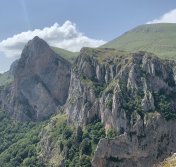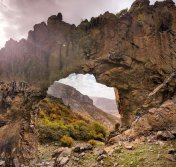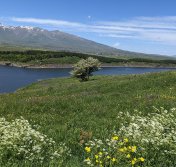What to expect
Imagine a green valley surrounded by snow-capped peaks. In the distance, you can make out your destination: a 17-meter-high waterfall that, from your vantage point, looks like a small white dot. Through the valley, underneath the grass, small streams formed from snowmelt snake their way down the mountain. Following the water, like streams themselves, are blue, white, yellow, and pink wildflower blossoms. As you venture further and further into the valley gaining elevation, the temperature begins to drop, and the cool breeze coming down from the mountain intensifies. At the same time, the sun’s rays get stronger and stronger on your skin, keeping you warm.
As you move closer to your destination, the waterfall that looked like a white dot not too long ago is now beginning to take shape. You can now see its cascading waters, though you still can’t appreciate its immense size from your location. You also notice large tents set up in the distance. These belong to the Yezidis, an ethnic and religious minority group in Armenia. They live in the mountains between the spring and fall months with their livestock, which graze in these mountain pastures.
You’re now close to the waterfall. You can clearly see its waters coming down from the mountain and unleashing a misty spray that’s carried away by the wind. All around you tower huge mountains like the walls of a mighty fortress. The valley is now filled with a mysterious fog. The grass is sprinkled with blooming wildflowers. A young man tends to his cows who are grazing on the grass and flowers. As you move closer and closer to the waterfall, you have to climb over medium-large sized boulders. Now you can hear it: the roar of the falling water. It’s constant, steady, and drowns out most other sounds.
You can now feel the mist of the waterfall on your face. But you can also feel raindrops from above. Out of nowhere, clouds begin to move into the valley sky above, and the raindrops turn into hail, before you hear a loud CRACK in the sky. It’s a thunderstorm. You find a boulder protruding out from the earth with just enough room for you and your friends to take cover under while the storm passes through the valley. You watch as the wind carries the rain, hail, mist, fog, and clouds away. The storm has passed.
You come out of your hiding place and continue your exploration of the valley. All the while, the roar of the waterfall softly rings in your ear. After lunch, its time to head back down the mountain the way you came. As you pass the tents, a Yezidi man waves to you. As you approach he greets you, and asks you if you’d like to come into his tent for a cup of coffee. Yes, of course you do. Inside the large tent, you gather around a small table for coffee, homemade fruit distillate, and the tastiest, freshest cheese you’ve ever had.
Before you leave, he gives you more cheese to take home with you. As you make your way down the mountain, it begins to rain again. There’s no place to hide, so you accept your fate. As you make your way down the mountain in the rain, you reflect on the awesome experience you just had, and are glad you decided to hike to Gegharot Waterfall.
Preparing for Gegharot Waterfall
The hike to Gegharot Waterfall will take you on a jeep track through a valley on a slope of Mt. Aragats. Due to its length (about 10km one way) it’s considered a challenging trail, though in total you’ll only gain about 100 meters of elevation. You can find more information on the trail, as well as a GPS map, over at AllTrails.
We recommend that you take with you anything that you would normally pack for a long, day-long hike, plus waterproof or resistant gear. Rain, hail, and thunderstorms are common in the spring and summer months, which come down directly from the summit of the mountain, and there’s no tree coverage along the trail or at the waterfall, so if rain is in the forecast on the day you plan on hiking, be prepared to get wet. There’s also no tree cover on this trail, so be sure to bring protective gear
Even if rain isn’t in the forecast, it’s hard to resist the desire to get close to the waterfall and feeling its misty spray, so either way you’re likely to get wet on this hike.
Here’s a list of what to bring on your adventure to Gegharot Waterfall:
Waterproof hiking boots
Poncho or other waterproof outerwear
Waterproof socks (bring an extra pair just in case)
Extra pairs of underwear and shorts/pants, an shirt and sweater
Walking sticks
Hat, sunglasses, and sunscreen
At least 2 liters of water
Lunch and snacks
Getting to Gegharot Waterfall
To get to Gegharot Waterfall, you first need to get to Aragats village, located about an hour away from Yerevan in the Aragatsotn Province. The drive there is pretty straight forward. If you don’t have wheels while traveling in Armenia, you can always book a ride with GG Taxi, a local taxi app. If you’ll need a ride back from Aragats to Yerevan, we recommend you talk to your driver to see if they’ll agree to pick you up again at the end of your adventure. More often than not local drivers will agree. Agree on a pick up time and location with your driver, and don’t accept a rate higher than what it cost them to take you Aragats.
From Aragats village your hike will begin. It’s hard to get lost on the trail, as it’s a single dirt road that leads directly from the village into the valley described earlier where the waterfall is located. This is a long hike, about 10kms one way, so we recommend you start early and plan to be out on the trail all day.
What to do once there
What do you do once you’ve found that perfect patch of green grass in the valley to view the waterfall? Enjoy it! If you have room in your backpack and don’t mind carrying them for a total of around 20kms, bring any outdoor gear you may need to get comfortable, like an outdoor mat and blankets. As always, show the land the utmost respect, and if you do bring a picnic lunch with you, clean up after yourself and leave no trace behind. There are no amenities along the trail and at the waterfall, so be sure to pack plenty of water and food for your day-long adventure.


